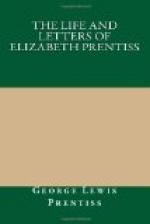From her earliest years she was in the habit of keeping a journal, and she must have filled several volumes. I wonder that she did not preserve them as mementos of her childhood and youth. Perhaps because her afterlife was so happy that she never needed to refer to such reminiscences of days gone by.
I have thus given you, in a very informal manner, some recollections of her earlier years. I have been astonished to find how vividly I recalled scenes, events and conversations so long past. I was startled and shocked when the news came of her sudden death. But I can not feel that she was called to her rest too soon. She seemed to me singularly happy in all the relations of life; and then as an author, hers was an exceptional case of full appreciation and success. I have ever regarded her as “favored among women”—blessed in doing her Master’s will and testifying for Him, blessed in her home, in her friends, and in her work, and blessed in her death.
PORTLAND, December 31, 1878.
* * * * *
IV.
The Dominant Type of Religious Life and Thought in New England in the First Half of this Century. Literary Influences. Letter of Cyrus Hamlin. A Strange Coincidence.
A brief notice of the general type of religious life and thought, which prevailed at this time in New England, will throw light upon both the preceding and following pages. Elizabeth’s early Christian character, although largely shaped by that of her father, was also, like his, vitally affected by the religious spirit and methods then dominant. Several distinct elements entered into the piety of New England at that period, (1.) There was, first of all, the old Puritan element which the Pilgrim Fathers and their immediate successors brought with them from the mother-country, and which had been nourished by the writings of the great Puritan divines of the seventeenth century—such as Baxter, Howe, Bunyan, Owen, Matthew Henry, and Flavel—by the “Imitation of Christ,” and Bishop Taylor’s “Holy Living and Dying,” and by such writers as Doddridge, Watts, and Jonathan Edwards of the last century. This lay at the foundation of the whole structure, giving it strength, solidity, earnestness, and power. (2.) But it was modified by the so-called Evangelical element, which marked large sections of the Church of England and most of the Dissenting bodies in Great Britain during the last half of the eighteenth and the early part of the nineteenth century. The writings of John Newton, Richard Cecil, Hannah More, Thomas Scott, Cowper, Wilberforce, Leigh Richmond, John Foster, Andrew Fuller, and Robert Hall—not to mention others—were widely circulated in New England and had great influence in its pulpits and its Christian homes. Their admirable spirit infused itself into thousands of lives, and helped in many ways to improve the general tone both of theological and devotional




